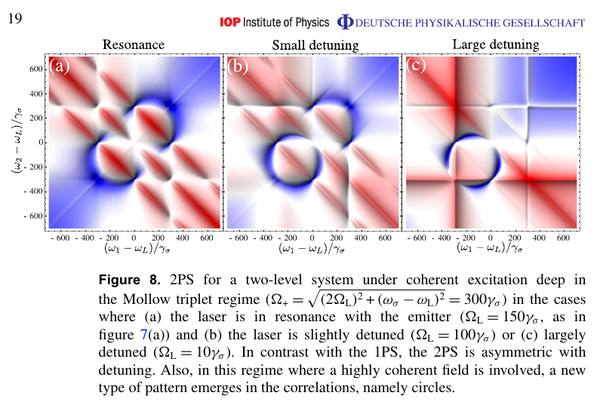Two-photon spectra of quantum emitters. A. González-Tudela, F. P. Laussy, C. Tejedor, M. J Hartmann and E. del Valle in New J. Phys. 15:033036 (2013). ![]()
This paper introduces for the first time—and computes explicitely for various cases—the two-photon correlation spectrum (or "two-photon spectrum" as per the nomenclature of the paper), that is, the 2D landcape of photon correlations when retaining their frequency degree of freedom.
We made a "video abstract" to explain the main idea (also available on the editor's website):
This is, for instance, the 2PS (two-photon spectrum) for the Mollow triplet:

We understood the triplet of red antidiagonal lines right away (they are leapfrog processes) but it would take another decade for us to figure out the blue circles![1]
The two-photon spectrum has been measured experimentally for the first time by Peiris et al.,[2] which is the most interesting case, and shortly after that by Silva et al.[3] but for something with much less quantum structure.
Such 2D structures remain ignored by the bulk of quantum opticians, who, to date, fail to understand that to look at two-photon observables, one must look at two-photon spectra. In this way, people remained oblivious to the strongly-correlated emission away from the spectral peaks that, if you Purcell-enhance it, gives rise to a new regime of quantum emission.[4]
References
- ↑ Two photons everywhere. E. Zubizarreta Casalengua, F. P. Laussy and E. del Valle in Phil. Trans. R. Soc. A 382:20230315 (2024).

- ↑ Two-color photon correlations of the light scattered by a quantum dot. M. Peiris, B. Petrak, K. Konthasinghe, Y. Yu, Z. C. Niu and A. Muller in Phys. Rev. B 91:195125 (2015).
- ↑ The colored Hanbury Brown-Twiss effect. B. Silva, C. Sánchez Muñoz, D. Ballarini, A. González-Tudela, M. de Giorgi, G. Gigli, K. West, L. Pfeiffer, E. del Valle, D. Sanvitto and F. P. Laussy in Sci. Rep. 6:37980 (2016).

- ↑ Emitters of $N$-photon bundles. C. Sánchez Muñoz, E. del Valle, A. González Tudela, K. Müller, S. Lichtmannecker, M. Kaniber, C. Tejedor, J.J. Finley and F.P. Laussy in Nature Photon. 8:550 (2014).
